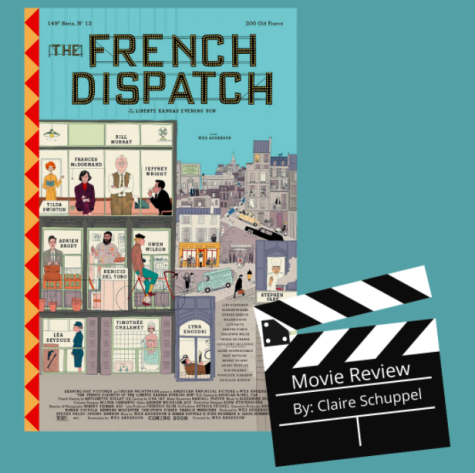“The French Dispatch” is not your typical Wes Anderson film
Nov 4, 2021

Director and screenwriter Wes Anderson’s long-awaited tenth film “The French Dispatch” was released Oct. 29. The filmmaker’s body of work is widely respected, with titles such as “The Grand Budapest Hotel,” “Fantastic Mr. Fox” and “Moonrise Kingdom.” Does his 2021 release hold up against his previous films?
“The French Dispatch” is a strong entry in Anderson’s filmography, as it bears a strong resemblance to his usual style of filmmaking. It is packed with an interesting story, a star-studded cast, stunning visuals, fitting music and the use of other elements makes this your typical Wes Anderson movie. Breaking down each of these components can give a strong basis for what makes and breaks this movie.
The story of “The French Dispatch” is based around an American newspaper based in France. The film opens with the death of the newspaper’s editor, Arthur Howitzer Jr., portrayed by Bill Murray. While reading his will, the staff discovers that the newspaper will be terminated with his death. The film features three previously written stories for their farewell issue, an anthology depicting three main sections of the paper: arts, politics and food. While at times difficult to follow, it is still engaging for the audience.
The stories are supplemented by the talent in the film. The writing staff of the film’s newspaper features Bill Murray, Owen Wilson, Elizabeth Moss and Jason Schwartzman. The first section of the newspaper, arts, most notably follows an incarcerated artist, portrayed by Benicio del Toro, and his muse, Léa Seydoux. Politics contains the story of a student revolt, led by Timothée Chalamet’s character and documented by Frances McDormand’s character. The food section recounts the kidnapping of a policeman’s son, with Jeffrey Wright’s character describing the events to Liev Schreiber’s character. As per usual, Anderson’s cast delivers on acting, with the typical charm of blunt line delivery and mellow emotion.
The use of the camera in “The French Dispatch” contributes to the storytelling of the plot throughout the film. Anderson’s shot composition is so distinct, and this again fits the mold. He maintained many of his usual camera techniques, such as full frame shots of intricate sets and his symmetrical, still angles, but there was successful experimentation with the camera. There were more tracking shots where the camera looked as if it were sitting on a bike or a wheelchair, there were circular tracking shots around characters and there were used skills refined to perfection. Overall, the use of the camera was not only consistent, but maybe better than most of his other films.
Anderson’s cinematography and camera techniques are some of his more consistent trademarks, as many film lovers could recognize one of his films with a single shot. The cinematography in “The French Dispatch” perfectly matches his previous, more refined works, as it has a fantastical dollhouse aesthetic throughout the movie. Each Anderson film will have a distinct color palette that can be associated with the movie, and this movie is no exception. Cinematographer Robert Yeoman, who has collaborated with Anderson on six projects, used a mixture of cool shades of blue and black and white footage for the film, which works well with other elements of the film.
Anderson frequently collaborates with composer Alexandre Desplat on his film scores, and he again brought the extra bit of lightness to the film. His scores for Anderson’s films are often filled with plucking string instruments to match with the jovial and youthful nature of the painted sets. This, aided with some great songs such as “I’ve Seen That Face Before (Libertango)” by Grace Jones and “Tu M’as Trop Menti” by Chantal Goya all can emulate the energy of music during the time of the stories told on the screen.
While the film is overall strong, there are some points where “The French Dispatch” falls short of a perfect rating. Anderson has successfully experimented with stop motion animation with “Fantastic Mr. Fox” and “Isle of Dogs,” but had yet attempted the 2D animation format. There is a short portion of the last story that is animated during a car chase, and it did not match the aesthetic of his previous works. It seems out of place and the animation style does not reflect the mid-20th century mood the rest of the film provides. We have seen Anderson pull off intricate car chases or action sequences before, often done comedically, so it felt forced in the film.
Another aspect of the movie that became distracting was the switches from black and white to color. While it is used as a tool to switch between the past and present in the story, there are moments in the film where those rules are not upkept and color is brought into the newspaper sections. It works for brief moments, like featuring an inmate’s art, but having entire shots in color makes the black and white less purposeful. That is one of the most outward examples of how this is not a completely focused Anderson film.
Overall, “The French Dispatch” delivered in a lot of the typical Wes Anderson ways, especially with its use of color and quick storytelling. I do not think it would be fair to put this on the same level as “The Grand Budapest Hotel,” as that is widely regarded as his best and most focused piece of work. The film is a four out of five star rating from me, but that score is dependent on what one is looking for from this film. It is an enjoyable feature and a feast for the eyes, so I would recommend it for casual movie-goers.












